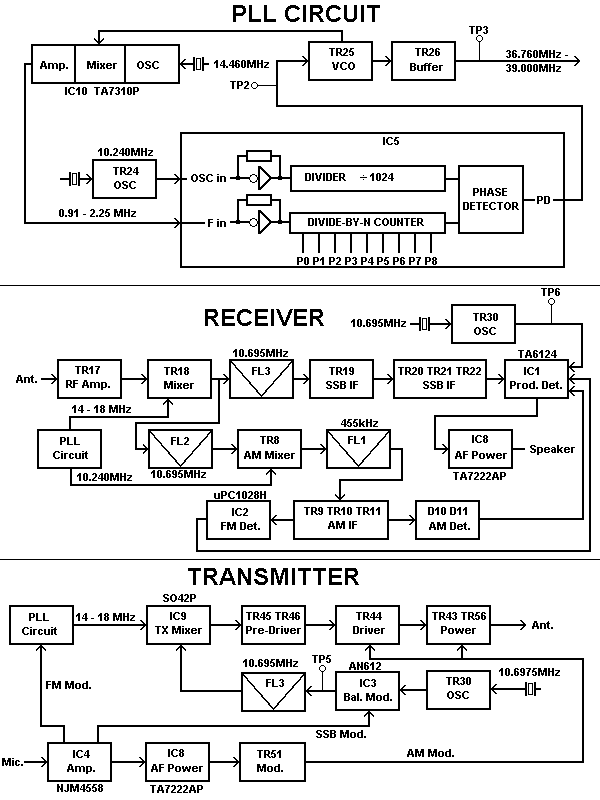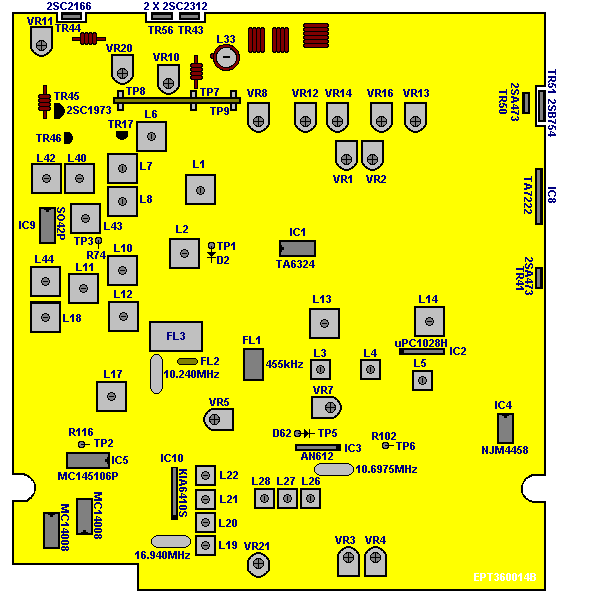SuperStar 3900
Alan 87
Alan 8001
Cobra 148GTL-DX
Eagle 2000
Galaxy
DX99V
Mirage 88
Sommerkamp TS-790DX
SuperStar 390FM (New)
I make a special EPROM expansion board that will add 4 more
bands to many radios that use either Binary or BCD programming, it also adds a
10KHz shift function as well, click here to find out
more.
It will give 1 band down, 1 band up, UK 40 (up 64 channels
without Alpha ch hops), NZ 40 (down 63 channels) and 10KHZ shift.
On a
40 channel radio it will give coverage from 26.335 to 28.005 (including the
normal low,mid and high bands of 26.515-27.855), that is a total of 167 channels
!
I can also make a custom board upon request which will give whatever
frequency range you want (within the limits of the radio).
Circuit Theory
PLL Circuitry. PLL is an
abbreviation of the phase-locked loop which is fundamentary composed of a closed
loop feedback citcuit. The feedback component is the balance of frequency drift
and the PLL circuit acts to cancel it out. To detect out the frcquency drift of
the PLL output, a fixed reference ocillator (10 kHz, 1/1024 divided down from
10.240 MHz) is compared constantly with the input frequency (10 kHz). The input
frequency is obtained by dividing the VCO frequency. A functionalI block diagram
is provided below under "PLL Circuit" for the easier
understanding.
Off-Set frequency oscillator IC10. The
off-set-frequency oscillator IC10 oscillates at 14.460 MHz for all band.
Switching between these oscillating frequencies is made by biasing the diodes
D34 to D36.
The off-set frequency signal is obtained at IC10 Oscillator and
flows into IC10 Mixer where it is beat with the VCO signal. The VCO signal is
obtained from the following:
f vco = foff-set +
Nfr
Where, f vco = VCO frequency, N = programming code
for divider output, and fr = referency frequency step (10kHz).
i.e.: At
channel #1 in band A, and band corresponding N code is 91:
f vco =
14.010 + 91 x 0.01 = 14.920MHz.
Since the mixer output determined by two
factors the off-set frequency output (dependent on band selector switch) and the
VCO output, the mixer output contains the subtracted frequency of 0.91 to 2.25
MHz. These frequencies appears in pin #2 of IC5, and divided by the programmable
divider in IC5 down to 10 kHz which is compared with another 10kHz signal
obtained from the reference oscillator TR24 (10.240MHz).
The VCO output is
mixed with the off-set frequency signal and applied to the TX mixer IC9 through
band-pass filters.
i.e. At channel 1 in band A, and AM band, the TX mixer IC9
accepts 14.920 + 10.695MHz = 25.615MHz is TX frequency.
When receiving channe
1 in band A (26.065MHz), the 1st RX mixer TR18 accepts 15.370 local ignal at its
base, and converts down it down to 10.695MHz IF (for AM/FM mode, this is the 1st
intermediate frequency). TR18 off-sets the 10.695MHz signal so that TR30 can
oscillate at 10.6975MHz for LSB. 
Adjustment

Test equipment
required:
|
|
|
|
| Power Supply: 13,8 V |
Frequency Counter |
Dummy Load 50 ohm |
Oscilloscope |
|
DC Amperemeter |
RF SSG |
AF SSG |
Preparation alignment:
|
|
| Clarifier |
Mid. |
| SQ GAIN |
Max. |
| AF GAIN |
Max. |
| RF GAIN |
Max. |
| MIC GAIN |
Max. |
| MOD, S/RF |
S/RF |
| NB/ANL |
Off |
| Band |
D |
| Channel |
19 |
| Reading Point |
Condition |
Adjustment |
Procedure |
| PLL |
|
|
|
| IC5 Pin 3 |
- |
Check |
10.2400MHz |
| TP2 |
Band:D, Ch.:40 |
L17 |
5,0 Volt |
| TP3 |
- |
L18 |
Maximum on Oscilloscope |
| OSCILLATOR |
|
|
|
| IC10 Pin 9 |
AM |
L19 |
16.9400MHz |
| IC10 Pin 9 |
USB |
L20 |
16.9425MHz |
| IC10 Pin 9 |
LSB |
L21 |
16.9375MHz |
|
|
|
|
| IC10 Pin 9 |
TX AM |
VR21 |
16.9400MHz (TX-Frequency) |
|
|
|
|
| TP5 |
TX AM |
L26 |
10.6950MHz |
| TP6 |
RX USB |
L27 |
10.6925MHz |
| TP6 |
RX LSB |
L28 |
10.6975MHz |
|
|
|
|
| TP5 |
TX USB |
VR7 |
SSB Modulator Balance |
|
|
|
|
| RECEIVER |
|
|
|
|
RX AM |
L6 L7 L8 |
RF Input |
|
RX AM |
L10 L11 L12 |
AM/FM/SSB IF |
|
RX AM |
L3 L4 |
AM/FM IF |
|
RX FM |
L5 |
Discriminator Coil (FM Demodulator) |
|
|
|
|
|
|
|
|
| TP1 |
RX USB |
L1 L2 |
Noise Blanker IF |
|
|
|
|
|
RX USB |
VR3 |
SSB Squelch |
|
RX AM |
VR4 |
AM/FM Squelch |
| AM/FM S- Meter |
RX AM |
VR1 |
|
| SSB S- Meter |
RX SSB |
VR2 |
|
| TRANSMITTER |
|
|
|
| TP9 (+) TP8 (-) |
Bias Driver |
VR11 |
10mA |
| TP9 (+) TP7 (-) |
Bias Finale |
VR10 |
100mA |
| TP9 (+) TP7 (-) |
Bias Finale |
VR20 |
100mA |
|
TX AM |
L42 |
Maximum |
|
TX AM |
L43 |
Mixer Coil (VCO-frequency input) |
|
TX AM |
L44 |
Mixer Coil (TX-carrier 10.695MHz input) |
|
TX AM |
L40 L42 |
Maximum RF output |
|
TX AM |
L33 |
Minimum Harmonic |
|
TX AM |
VR13 |
15 Watt (30 Watt with Dual Finale output) AM/FM |
|
TX USB |
VR12 |
20 Watt (40 Watt with Dual Finale output) SSB (ALC) |
|
TX AM |
VR14 |
90% AM-Modulation (AMC) |
|
TX FM |
VR5 |
2 kHz FM-Deviation |
|
TX CW |
VR16 |
CW Tone (Not in all model`s) |
| Power Meter |
TX AM |
VR8 |
|
|
|
|
|
|
|
|
|
|
|
|
|
Microphone Connection
| Pin |
Description |
| 1 |
Ground |
| 2 |
Microphone |
| 3 |
TX Key (Connect to Ground) |
| 4 |
Speaker (Connect to Ground) |
This counter shows the number of hits since the 7th November
1999

Go
Back To The Alignments Page
Go Back To The
Main Home Page
Copyright © The Defpom 1997-2005
http://www.radiomods.co.nz/


